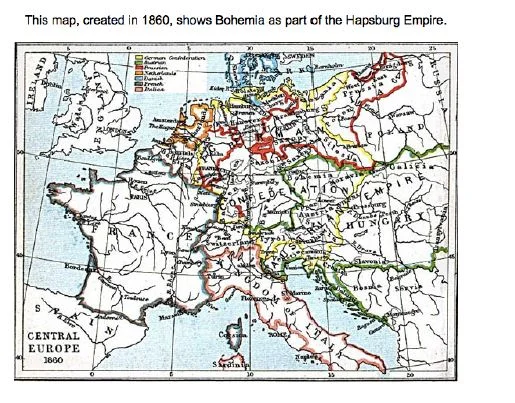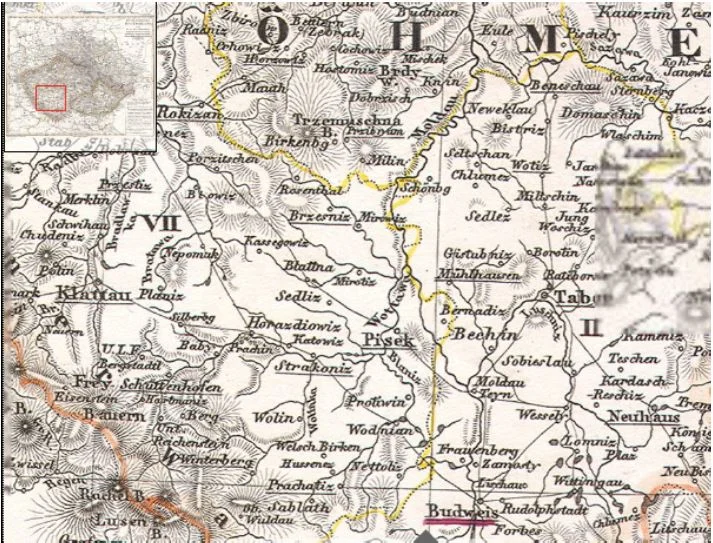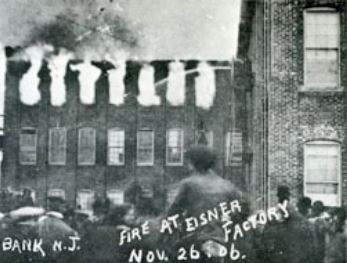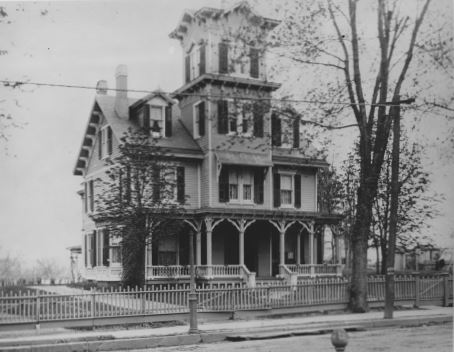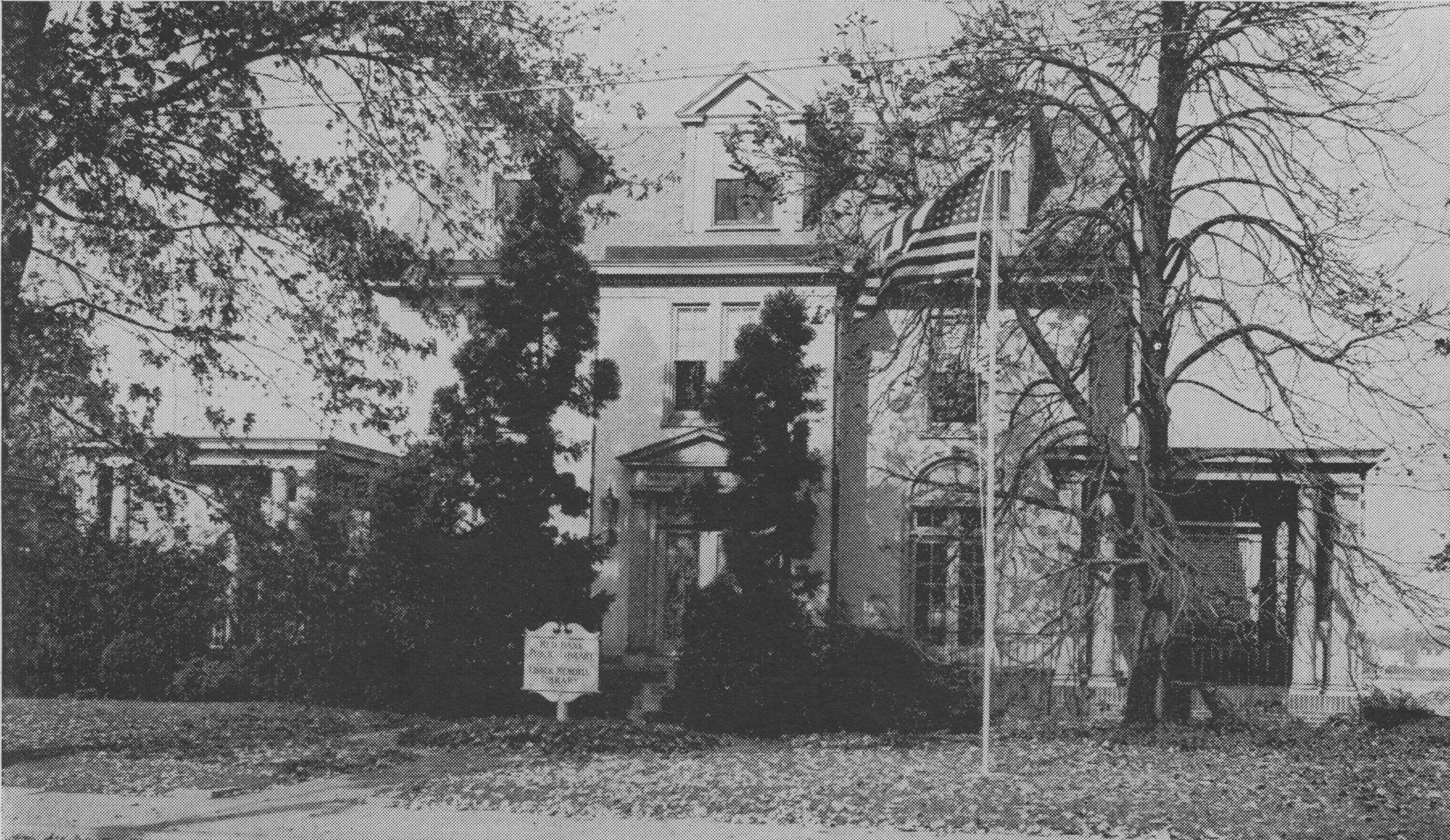The Eisner Family of Red Bank
Sigmund Eisner, his family and the factory they founded in Red Bank had a lasting impact on the community. The building that houses the Red Bank Public Library was a gift from the Eisner Family. The family has chosen to share some of their history through gifts to the Eisner Memorial Red Bank Public Library. Some are available through this web site and others are available in the Local History Room at the library. Please contact the library for additional information.
THE EISNER FAMILY STORY
Written by Liam Collins, Volunteer for the Eisner Memorial Library, Red Bank, NJ March 2018
Sigmund Eisner was born on St. Valentine’s Day, February 14th, 1859 in Bohemia. He was the founder of Sigmund Eisner Company in Red Bank, NJ. His wife, Bertha (nee Weis) Eisner’s family were already an established business family in Monmouth County. They had a milliner/clothing shop and dealt in furs. [i]
Bertha’s father and mother were Elias Weis (born 20 February 1823 in Pernatitz – d. Red Bank, NJ 1903) and Hannah Schwartz (b 1831 in Shoenwald d. 1908 in NY). Both are buried at the Linden Hill Cemetery in Brooklyn, NY. Hannah was born to Isaac Schwartz (b. 1795 – d. 1867 in NY) and Rosie (Therese) Auerbach (b. 1805 – d. 1852 in NY). In 1845, the Schwartz Family moved from Shoenwald, Bohemia (Austro-Hungarian Empire). They settled in the village of Tennent (near Freehold), New Jersey.
Elias and Hannah were married in Bohemia. Elias arrived in America in 1855. Their daughter, Bertha (the future wife of Sigmund), was born in Pernatitz in January, 1856. She and her mother followed to America in 1857 from the western region of Bohemia near the Bavarian border, a part of the Austro-Hungarian Empire. They first arrived in New York and lived there for a couple of years before making the move to Black Mills, Monmouth County a mile or so from Tennent, where Hannah’s parents (Issac and Rosie Schwartz) were already living.
In 1870, the Weis Family moved to Red Bank, NJ. Elias and Hannah had eight children, however, only four survived into adulthood: Bertha, Abram Max, Ida and Rosa. Upon arriving to Red Bank, the family opened a Millinery and Fur shop on Front Street (middle of the block facing South down Broad Street – approximately where “Bark Avenue” pet store is now). This wooden framed shop burned down in 1881, and they rebuilt the store in brick. In 1895, they purchased a plot of land from Elisha White’s estate on the East side of Broad Street. They erected a brick building on the site and called it the ‘Temple of Fashion’. The family lived in the quarters above the shop. The silver anniversary of the opening of their shop was celebrated in 1900. [ii] In 1903 Elias Weis died. [iii] The business was liquidated in 1916.
Bertha’s brother, A. (Abram) Max Weis, also became a prominent citizen of Red Bank. He was a major property owner in Red Bank and leased the building for the first theater in Red Bank on Monmouth Street. He was also the chairman of the committee to open Front Street to the river in 1911. Max died in 1917 and left a large track of land on the river front near Buena Vista Place to his nephew Monroe. Monroe later bequeathed this land to his younger brother Victor as a wedding present. [iv]
Bertha’s sisters Rosa and Ida were involved in many charitable events throughout their lifetimes. They donated a lot of their time to community activities as well as national and international events. They traveled on several occasions to the West coast with their family and were involved in the first coast to coast call made to Red Bank from California.[v] After the business closed, the Weis siblings moved next door to the Eisner’s on Front Street overlooking the river.
In 1882, Sigmund Eisner came to America. The same day he arrived in New York he travelled down to New Jersey to stay with his uncle and aunt in Newark. They had come fifteen to twenty years earlier. After visiting with his uncle and aunt for a short time, he moved to Keyport, Monmouth County, New Jersey, where he lived with his cousin who had come over a few years earlier. The two became itinerant merchants (peddlers). On one of Sigmund’s visits to Red Bank, he met the Weis Family. They bonded over a common language and that he came from the same vicinity of Bohemia where the Weis Family originated. [vi]
A year or so later in about 1884, Sigmund began manufacturing men’s summer clothing. In 1885, Sigmund Eisner and Bertha Weis were married in Red Bank by Rabbi Wise. The couple lived on Mechanic Street and used the front parlor of the house as a workshop where they employed four people and had two sewing machines. Their two eldest sons, Raymond and Lester were born there. Late in 1889, they moved to 76-78 Wallace Street, where the next two sons, Monroe and Victor were born. They now employed 15-20 people and the enterprise occupied one half of the two-family home while the family resided in the other half. [vii]
In 1898, during the Spanish-American War, Sigmund Eisner was awarded a contract for uniforms for the United States Army. He started a partnership with Mr. Werle of Brooklyn under the firm name of Werle and Eisner with a New York office at No. 105 Broadway, NY. The partnership was dissolved by mutual consent in 1901. [viii]The second half of the two-family house was not an adequate amount of space to function and soon Sigmund and Bertha purchased the old Gill bakery shop on the north side of Wallace Street, [ix]a two-storied building approximately 30 x 80. Around 1899, they bought the Starr Home on West Front St (the library) and made it into their home. [x]
The industry continued to grow and soon the bakery building was not spacious enough. In 1904, Sigmund built the first unit of the factory on the Henry Field stone yard on Bridge Avenue. It was a three-story building, 45 x 90. A year or two later, a similar unit was added. The industry continued to grow, and another factory was purchased in Freehold, NJ about fourteen miles from Red Bank.
In 1906, he built the largest office building in Red Bank (currently housing Restoration Hardware). This was formerly the Sutton property.
In 1910, Theodore Roosevelt was inspired by the Boy Scout movement in Britain and decided to establish a similar organization in America. A group of men were called to Washington, D.C., including Sigmund Eisner. The movement was established and for the first two years Sigmund Eisner personally financed and manufactured all the Boy Scout uniforms.
By 1914, the business had grown so that it was the largest uniform manufacturing company in the world. [xi]More buildings were added during the first world war. Another factory was acquired during the first war in Newark, NJ. He also opened factories in Long Branch, South Amboy, Chrome, Carteret and Elizabeth. The reason for the acquisition of factories at places other than Red Bank was because of the scarcity of skilled labor. In those days, Red Bank was primarily a residential community. The number of employees during World War One swelled to 5,000. In 1918, the weekly payroll was $60,000.
In 1916 the company was incorporated by Sigmund and his four sons. [xii] In 1918 the factory was producing over 1,000,000 Boy Scout uniforms annually. Since 1910 until the 1940’s (except for 1932-36), millions of Boy Scout uniforms had the Eisner Red Bank label. When Sigmund Eisner first started his business, the population of Red Bank was only about 3,000. By the end of World War Two it was four times that size.
By 1922, the number of Eisner employees had decreased to 2,000, but it was still the largest employer in Red Bank. In addition to producing uniforms for the United States, the company also produced uniforms for Britain, Belgium, Italy and France – all procured in the United States.
Sigmund Eisner served as the Water Commissioner of Red Bank and Vice President of the Monmouth Memorial Hospital in Long Branch. He organized the Red Bank Play Ground Association; he was Chairman of practically all welfare drives in the community during World War One. For years, he served as the county Vice-Chairman of the American Red Cross. For more than twenty years, and until his death in 1925, he was a member of the board of the Second National Bank of Red Bank, the largest bank in Monmouth County. He was a member of the Monmouth County Organization for Social Services, and one of the main financial supporters. He was a member of the New Jersey State Reform School for Boys at Jamesburg. He was a founding member of the YMCA in Red Bank. Always actively engaged in every civic enterprise in the community, he was, at his death in 1925 recognized as “Red Bank’s First Citizen,” and one of the foremost civic leaders in the state of New Jersey.
Sigmund and Bertha’s children all were born and raised in Red Bank. They had four sons: Raymond, J. Lester, Monroe and Victor.
In 1912, Raymond married Elsie Solomon and established their home in red Bank. He and Elsie had one daughter named Sarann (b. 1915) A year or two later, he built a house at 303 Broad Street in Red Bank, NJ and brought up his family there. (This building was where Wells Fargo Bank is currently on the corner of Broad Street and Bergen Pl.). Upon his father Sigmund’s death, Raymond became the president of the Sigmund Eisner Company. He was educated at Harvard University and Philadelphia Textile School. He succeeded his father Sigmund as a member of the New Jersey State Reformatory School for Boys at Jamesburg as well as Vice President of the Monmouth County Organization for Social Service. Raymond later established a residence in New York City as well as Red Bank. He worked from the company offices at 261 5th Avenue in New York. He was a member of the Monmouth Boat Club, Hollywood Golf Club in Deal and was a Mason and an Elk. He died at Mt. Sanai Hospital in NY and is buried at B’nai Jeshurum cemetery in Elizabeth, NJ. Sarann’s first husband was named Jerry Burnham (b. 1911) and later she married Herb Strauss (b. 1919).
In 1913, J. Lester Eisner married Maddie Davidson (b. 1891 – d. 1924), and he likewise established his home in Red Bank. He built his first house in 1916 at 247 Broad Street in Red Bank, NJ (now the Methodist Church). His children J. Lester Jr. (b. 1915), Gerald (b. 1920) and Jack (Jacques) (b. 1918 – d. 1943) all attended the public schools of Red Bank, as did Erwin Steiner, the first year of J. Lester’s second marriage to Virginia Steiner (b. 1897 – d. 1980). All of J. Lester’s boys were members of the Boy Scouts of America and participated in all local junior activities. Upon the death of his father, Sigmund, J. Lester became the vice president of Sigmund Eisner Company. He was chairman of the state NRA 1933-34, former member of the Red Bank Board of Education and former vice president of the Monmouth County Welfare Board and children’s shelter. He was director for transportation for the American Red Cross European Theatre during WWll. [xiii] His son, J. Lester Jr. (b. 1915) married Maggie Dammann (b. 1916) and they had two children: Michael (b. 1942) and Margot (b. 1940). Michael went on to become the CEO of Walt Disney Company. J. Lester’s youngest son Jacques was killed in action in WWII, serving aboard the U.S.S. San Francisco at the Solomon Islands. A Navy Escort Destroyer, the U.S.S. Eisner, was named in his honor. J. Lester became a Lt. Col. In the Federal Reserve corps but was transferred to the New Jersey National Guard when he was appointed by Governor Larson as a member of his personal military staff in 1955.[xiv]
In 1917, Monroe married Winone Jackson. He, like his brothers, also established his home in Red Bank. He built a house on the hilltop property of the town of Red Bank (191 Prospect Avenue). (This is now Tower Hill Condominiums). He also owned all the land down to McLaren Street as well as all the land later known as John Street Woods, a large plot of land directly across Harrison Avenue from the John Street woods land going towards Fair Haven, and all of what is now Manor Drive. The estate comprised the large mansion where Monroe and Winone lived. As you pulled into the driveway off prospect Avenue, the main driveway went from East to West. It was a gravel driveway which made a rumbling/crackling sound as you drove on it. On the right side was a small Dutch colonial style house of natural brown cedar shingle. This house was occupied by the Green family. They were caretakers of the land. To the left was a white paddock style fence and open pasture. At the top of the pasture, up the sloping lawn, was a large white house. As you continued up the driveway, the drive bent slightly to the right and here there was a tall hedge on the right-hand side. On the left-hand side was a small brick cottage. This house was occupied by the Reilly family. Mrs. Reilly worked as the house manager in the mansion while Mr. Reilly was also a caretaker like Mr. Green. His duties also included taking care of the horses. Between the hedge on the right was a space and the driveway continued through up to the mansion residence of Monroe and Winone. To the left of the driveway was a well-manicured lawn. If you went back out to the hedge and followed ahead in front of the caretaker’s cottage, the driveway sloped down to the left and behind the cottage. Behind and underneath the cottage were the stables for the horses. There were greenhouses back behind the cottage. There was also a gas pump for filling the cars and tractors with fuel. (This is a memory from Liam Collins personal memory as his ‘aunt and uncle’ – The Reilly’s were caretakers on the estate and Liam spent a lot of time there as a child. Also, when Liam used to play up on the estate, Monroe had been married to his second wife known as “Frankey’).
Monroe and Winone had one son, Robert Eisner. Robert had two daughters: Kathy and Jan. (They lived in the large white house to the left when first driving into the estate.)
After the death of Sigmund in 1925, Monroe became the secretary and treasurer of the Sigmund Eisner Company. He succeeded his father, Sigmund on the Board of Monmouth Memorial Hospital, Vice-Chairman of the Monmouth County Red Cross and Vice President of the Monmouth County Council of Boy Scouts of America.
When Victor (b. 1895 – d. 1933) Eisner married Helena Monsky (b. 1897), he like his brothers, established his home in Red Bank. 1n 1920, his brother Monroe had gifted him land that had been left to him from his uncle A. Max Weis; however, in about 1925 he moved to California, where he took charge of the Sigmund Eisner Company business on the West coast. He received his early education in Red Bank and later at Mercerberg Academy. He began his career with the Eisner Company as the manager of the Long Branch plant, where he remained until the beginning of World War One when he was commissioned as lieutenant in the United States Army. At the close of the war, he took charge of the Eisner Company business on California. He died in San Francisco in 1933. Victor and Helena had two sons: Sigmund 2nd (b. 1920) and Victor Jr. (b. 1921). Victor Jr. had two children: Julie (b. 1960) and Larry (b. 1963). After Victor’s death in 1933, Helena remarried Merv Cowan.
Sigmund was born to Michael Eisner (b. 1830 d. 1910) and Katherine Bruml (b. 1837 Drosau d. 1898 Teplitz). He was the oldest of seven siblings: Therese (Resie) (b. 1860 d. 1945), m. Marcus (Michael) Bloch; Moritz (b. 1862 d. 1927) m. Johanna (Jeanette); Daniel (b. 1867 d. 1928) m. Eugenie; Marie (b. 1870 d. 1926) m. Ludwig Fleischner; Arnold (b. 1871 d. 1945) m. Olga; Julie ( b. 1873 d. 1945) m. Edmund Lederer. All continued to live in the area around Horazdowice in what later became the Czech Republic, but was occupied by Germany in WWII. At that time, the surviving siblings, along with many of their children and some of their grandchildren, were transported to death camps in Terezin and Auschwitz. Only four children of Sigmund Eisner’s siblings, his son’s first cousins, survived WWII along with several of their grandchildren. They are scattered in several countries around the world.
Bertha’s three siblings: A. Max (b. 1859 – d. 1910), Rosie (b. 1865 – 1935) and Ida (b. 1867 – d. 1930) were all born in New York and all died in Red Bank, NJ. Bertha, the eldest was the only one born in Pernatitz and she outlived all her younger siblings, none of whom ever married or had children.
In 1936, Sigmund’s wife, Bertha died and in 1937, the surviving sons: Raymond, J. Lester and Monroe inherited the Eisner Homestead on Front Street. They donated the home, completely furnished, to the Borough of Red Bank as the Eisner Memorial Library. The library building was originally built in 1856 by Mr. Stacey Pitcher. It was purchased in 1876 by William L. Loew who expanded and rebuilt the smaller house. The house was purchased by Sigmund and Bertha on March 21, 1906 for $6,000. They rebuilt the house on two occasions. The main living room, a mahogany wood paneled room was constructed in 1920. [xv]
Eisner Family Timeline
Before 1860: European Beginnings
January, 1856 - Bertha Weiss is born in Pernartitz, Bohemia
1857 - Bertha and her mother immigrate to America to join her father
February 14, 1859 - Sigmund Eisner is born in Horazdowitz, Bohemia
Bohemia in close-up
1880’s: Eisners Begin Life in Red Bank
The SS Werra: Sigmund Eisner arrived in America aboard this ship, in steerage.
1881 - At age 22, Sigmund Eisner travels through Hamburg Germany and arrives in New York.
S. Eisner goes to Newark to see his uncle, Jacob Eisner (who was instrumental in bringing most of the Eisner immigrants to Newark) and his cousin Henry.
Sigmund Eisner settled in Keyport; the Salz family friends, help him as he earns a living as a peddler of sewing supplies and notions, eventually adding a horse and cart.S. Eisner moves to Red Bank and meets Max Weiss, son of Elias and Hannah who own a successful millinery store
January, 1886 - Sigmund Eisner marries Bertha Weiss
Sigmund and Bertha Eisner settle on Mechanic Street, Red Bank, where Bertha sets up a sewing machine and starts making clothes
H. Raymond, eldest son is born in late 1886. 3 more Eisner sons are born: 1889 - J. Lester, 1893 - Monroe, and 1894 - A. Victor
1895-1920 The Sigmund Eisner Uniform and Clothing Factory Grows and Prospers
1895 - Eisner family and business move to Wallace Street
Jan. - April, 1896 - S. Eisner purchases Gill Bakery, on Wallace Street, and refurbishes it as a garment factory
April, 1889 - Eisner factory receives first government contract, making white duck suits for the Army
1902 - Sigmund Eisner purchases the Henry Field property
The Eisner Factory
Sigmund Eisner at Work
1905 - The Sigmund Eisner Uniform & Clothing Factory is built on Bridge Avenue in Red Bank
November, 1906 - Major fire at the Factory
December, 1906 - Factory is rebuilt with added safety features such as sprinkler system
November, 1911 - Eisner Factory signs major contract with Boy Scouts of America
1913 - Addition to factory is built
1914 - 1915 - Factory receives large government order for uniforms
1916 - Over 37 miles of cloth are used daily at the Eisner Factory!
1917 - Factory expands to take up additional buildings
July, 1918 - Eisner Factory is now the world’s largest producer of uniforms
Sigmund and Bertha Eisner Family Activities
Front Street House
1906 - Eisners move into 16 room home on Front Street and immediately remodeled it.
1909 - Eisners visit Bohemia for first time in several years, Sigmund Eisner and siblings above.
January 1911 - The Eisners celebrate their 25th Wedding Anniversary
August, 1918 - Jewish Relief Campaign
January, 1925 - Sigmund Eisner passes away
1936 - Bertha Eisner passes away
1937 - Eisner home is donated to Red Bank for use as a public library
Eisner House at time of donation to Red Bank to serve as a library.
The Eisner Family Collection
Upon the death of their Mother, Bertha Eisner, the Eisner sons gave the family home on Front Street to the Borough for use as a library. Since that time, the family has generously continued to support the library, including the gift of primary documents and memorabilia. In particular, the library gratefully acknowledges the trust and support of Gerry, Larry and Michael Eisner for their generous contributions. Over the past 80 years, other material has come from many sources. Please click here for more information about what is available in the Eisner Memorial Red Bank Public Library. Much of the Eisner Collection has been digitized and can be viewed from the Albums tab here.
Footnotes
[i] Red Bank Register 1901 January 30
[ii] Red Bank Register 1902 January 15
[iii] Red Bank Register 1903 January 21
[iv] Red Bank Register 1920 September 22
[v] Red Bank Register 1915 August 11
[vi] From a document donated to the library by Jerry Eisner
[vii] Red Bank Register 1896 September 2
[viii] Red Bank Register 1918 July 3
[ix] Red Bank Register 1911 January 18
[x] Red Bank Register 1918 July 3
[xi] Red Bank Register 1918 July 3
[xii] Red Bank Register 1918 July 3
[xiii] Red Bank Register 1955 June 2
[xiv] Red Bank Register 1955 June 2
[xv] Red Bank Register 1937 January 1


